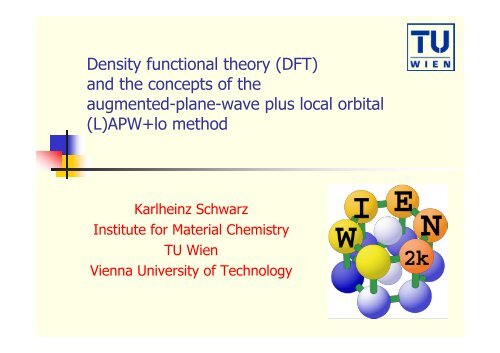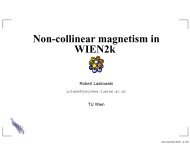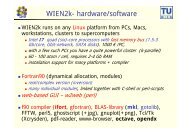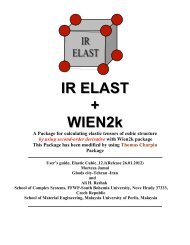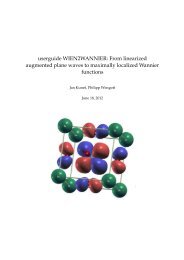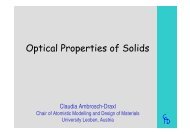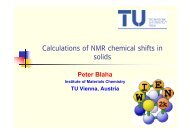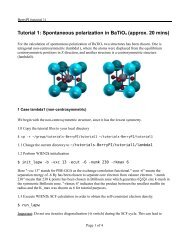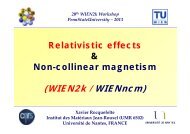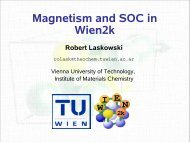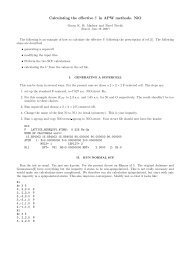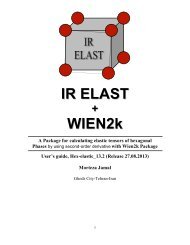Introduction to Solid State theory, DFT and the APW-method - WIEN 2k
Introduction to Solid State theory, DFT and the APW-method - WIEN 2k
Introduction to Solid State theory, DFT and the APW-method - WIEN 2k
- No tags were found...
You also want an ePaper? Increase the reach of your titles
YUMPU automatically turns print PDFs into web optimized ePapers that Google loves.
Density functional <strong><strong>the</strong>ory</strong> (<strong>DFT</strong>)<strong>and</strong> <strong>the</strong> concepts of <strong>the</strong>augmented-plane-wave plus local orbital(L)<strong>APW</strong>+lo <strong>method</strong>Karlheinz SchwarzInstitute for Material ChemistryTU WienVienna University of Technology
<strong>DFT</strong><strong>APW</strong>J.C.SlaterElectronic structure ofsolids <strong>and</strong> surfacesL<strong>APW</strong>O.K.Andersenhexagonal boron nitride on Rh(111)2x2 supercell (1108 a<strong>to</strong>ms per cell)Phys.Rev.Lett. 98, 106802 (2007)K.Schwarz, P.Blaha, S.B.Trickey,Molecular physics, 108, 3147 (2010)Wien<strong>2k</strong> is used worldwideby about 2200 groups
The <strong>WIEN</strong><strong>2k</strong> code: comments• Walter Kohn: density functional <strong><strong>the</strong>ory</strong> (<strong>DFT</strong>)• J.C.Slater: augmented plane wave (<strong>APW</strong>) <strong>method</strong>, 1937• O.K.Andersen: Linearized <strong>APW</strong> (L<strong>APW</strong>)• Wien<strong>2k</strong> code: developed during <strong>the</strong> last 30 years• In <strong>the</strong> year 2000 (<strong>2k</strong>) <strong>the</strong> <strong>WIEN</strong> code (from Vienna) was called wien<strong>2k</strong>• One of <strong>the</strong> most accurate <strong>DFT</strong> codes for solids• All electron, relativistic, full- potential <strong>method</strong>• Widely used in academia <strong>and</strong> industry• Applications:• solids: insula<strong>to</strong>rs , covalently bonded systems, metals• Electronic, magentic, elastic , optical ,…properties• Surfaces:• Many application in literature• See www.wien<strong>2k</strong>.at
A few solid state concepts• Crystal structure• Unit cell (defined by 3 lattice vec<strong>to</strong>rs) leading <strong>to</strong> 7 crystal systems• Bravais lattice (14)• A<strong>to</strong>mic basis (Wyckoff position)• Symmetries (rotations, inversion, mirror planes, glide plane, screw axis)• Space group (230)• Wigner-Seitz cell• Reciprocal lattice (Brillouin zone)• Electronic structure• Periodic boundary conditions• Bloch <strong>the</strong>orem (k-vec<strong>to</strong>r), Bloch function• Schrödinger equation (HF, <strong>DFT</strong>)
Unit cellAssuming an ideal infinite crystal we define a unit cell byUnit cell: a volume in space thatfills space entirely when translatedby all lattice vec<strong>to</strong>rs.cThe obvious choice:a parallelepiped defined by a, b, c,three basis vec<strong>to</strong>rs with<strong>the</strong> best a, b, c are as orthogonalas possible<strong>the</strong> cell is as symmetric aspossible (14 types)abA unit cell containing one lattice point is called primitive cell.
Crystal system: e.g. cubicAxis systemprimitivea = b = c = = = 90°body centered face centeredP (cP) I (bcc) F (fcc)
3D lattice types:7 Crystal systems <strong>and</strong> 14 Bravais latticesTriclinic 1 “no” symmetryMonoclinic (P, C) 2 Two right anglesOrthorhombic (P, C, I, F) 4 Three right anglesTetragonal (P, I) 2 Three right angles + 4 fold rotationCubic (P, I, F) 3 Three right angles + 4 fold + 3 foldTrigonal (Rhombohedral) 1 Three equal angles (≠ 90 o) + 3 foldHexagonal 1 Two right <strong>and</strong> one 120 o angle + 6 fold
Wigner-Seitz CellForm connection <strong>to</strong> all neighbors <strong>and</strong> span a plane normal<strong>to</strong> <strong>the</strong> connecting line at half distance
Bloch-Theorem:1 2 r2 V( r ) ( r ) E( )1-dimensioanl case:V(x) has lattice periodicity (“translational invariance”):V(x)=V(x+a)The electron density (x) has also lattice periodicity, however,<strong>the</strong> wave function does NOT:(x) (x a) (x a) (x)*( x)(x)* 1but:Application of <strong>the</strong> translation g-times:gg ( x) (x ga) (x)
periodic boundary conditions:• The wave function must be uniquely defined: after Gtranslations it must be identical (G a: periodicity volume):aG G(x) (x Ga) (x) (x)eDef . :Blochg2iGG 1g 0, 12,....2gk ea Gcondition : (x a) eikaika(x) kG a
Bloch functions:• Wave functions with Bloch form:kikx( x) e u(x)where : u(x) u(x a)Re [(x)]Phase fac<strong>to</strong>r lattice periodic functionxReplacing k by k+K, where K is a reciprocal lattice vec<strong>to</strong>r,fulfills again <strong>the</strong> Bloch-condition. k can be restricted <strong>to</strong> <strong>the</strong> first Brillouin zone .e2i Ka 1 aka
non relativisticsemi-relativisticfully-relativisticConcepts when solving Schrödingers-equation in solidsRelativistic treatmen<strong>to</strong>f <strong>the</strong> electrons1 2Form ofpotential(non-)selfconsistent“Muffin-tin” MTa<strong>to</strong>mic sphere approximation (ASA)Full potential : FPpseudopotential (PP)exchange <strong>and</strong> correlation potential k k k V( r)i ii 2 Hartree-Fock (+correlations)Density functional <strong><strong>the</strong>ory</strong> (<strong>DFT</strong>)Local density approximation (LDA)Generalized gradient approximation (GGA)Beyond LDA: e.g. LDA+USchrödinger – equation(Kohn-Sham equation)non periodic(cluster)periodic(unit cell)Representationof solidTreatment ofspinNon-spinpolarizedSpin polarized(with certain magnetic order)Basis functionsplane waves : PWaugmented plane waves : <strong>APW</strong>a<strong>to</strong>mic oribtals. e.g. Slater (STO), Gaussians (GTO),LMTO, numerical basis
<strong>DFT</strong> vs. MBT (many body <strong><strong>the</strong>ory</strong>)
Coulomb potential:• nuclei• all electrons• includingself-interactionQuantum mechanics:• exchange• correlation• (partly) cancelself-interaction
ESSENCE OF DENSITY-FUNTIONAL THEORY• Every observable quantity of a quantum system canbe calculated from <strong>the</strong> density of <strong>the</strong> system ALONE(Hohenberg, Kohn, 1964).• The density of particles interacting with each o<strong>the</strong>rcan be calculated as <strong>the</strong> density of an auxiliarysystem of non-interacting particles (Kohn, Sham,1965).Walter Kohn’s 80Ecole Normale Supérieur
Walter Kohn, Nobel Prize 1998 Chemistry“Self-consistent Equations including Exchange <strong>and</strong> Correlation Effects”W. Kohn <strong>and</strong> L. J. Sham, Phys. Rev. 140, A1133 (1965)Literal quote from Kohn <strong>and</strong> Sham’s paper:“… We do not expectan accurate description of chemical binding.”
<strong>DFT</strong> Density Functional TheoryHohenberg-Kohn <strong>the</strong>orem: (exact)The <strong>to</strong>tal energy of an interacting inhomogeneous electron gas in <strong>the</strong>presence of an external potential V ext (r ) is a functional of <strong>the</strong> density E Vext ( r ) ( r ) dr F [ ]Kohn-Sham: (still exact!) 1 (r ) (r ) E To[ ] Vext(r ) dr drdr Exc[]2 | r r |E kineticnon interactingE ne E coulomb E ee E xc exchange-correlationIn KS <strong>the</strong> many body problem of interacting electrons <strong>and</strong> nuclei is mapped <strong>to</strong>a one-electron reference system that leads <strong>to</strong> <strong>the</strong> same density as <strong>the</strong> realsystem.
Exchange <strong>and</strong> correlation• We divide <strong>the</strong> density of <strong>the</strong> N-1 electron systemin<strong>to</strong> <strong>the</strong> <strong>to</strong>tal density n(r) <strong>and</strong> an exchangecorrelationhole:Properties of <strong>the</strong> exchange-correlation hole:• Locality• Pauli principle• <strong>the</strong> hole contains ONE electron• The hole must ne negative• The exchange hole affects electrons with <strong>the</strong>same spin <strong>and</strong> accounts for <strong>the</strong> Pauli principle• In contrast, <strong>the</strong> correlation-hole accounts for <strong>the</strong>Coulomb repulsion of electrons with <strong>the</strong> oppositespin. It is short range <strong>and</strong> leads <strong>to</strong> a smallredistribution of charge. The correlation holecontains NO charge:
Kohn-Sham equationsEToLDA, GGA 1 ( r ) ( r ) [ ] Vext ( r ) d r dr dr Exc[ ]2 | r r |vary EELDAxcGGAxc{ 121-electron equations (Kohn Sham)(r)(r)2 Vext( r ) VC( (r))Vxc( (r))}-Z/r ( r) E ) drxc(| r r | hom.xc[ (r)]drF[(r),(r)]dri( r) i( r ) i( r )iE F| LDA treats both,exchange <strong>and</strong> correlation effects,GGA but approximatelyNew (better ?) functionals are still an active field of researchi2|
<strong>DFT</strong> ground state of iron• LSDA• NM• fcc• in contrast <strong>to</strong>experimentGGALSDAGGA• GGA• FM• bcc• Correct latticeconstantLSDA• Experiment• FM• bcc
<strong>DFT</strong> thanks <strong>to</strong> Claudia Ambrosch (Graz)GGA follows LDA
CoO AFM-II <strong>to</strong>tal energy, DOS• CoO• in NaCl structure• antiferromagnetic: AF II• insula<strong>to</strong>r• t 2g splits in<strong>to</strong> a 1g <strong>and</strong> e g ‘• GGA almost spilts <strong>the</strong> b<strong>and</strong>sGGALSDA
CoO why is GGA better than LSDA• Central Co a<strong>to</strong>m distinguishesVxc VGGAxcVLSDAxcCo• between• <strong>and</strong>CoCoO• Angular correlationCoCoCo
FeF 2 : GGA works surprisingly wellLSDAGGAFe-EFG in FeF 2 :LSDA: 6.2GGA: 16.8exp: 16.5FeF 2 : GGA splitst 2g in<strong>to</strong> a 1g <strong>and</strong> e g ’agree
Accuracy of <strong>DFT</strong> for transition metalsLattice parameters (Å)Exp. LDA PBE WCCo 2.51 2.42 2.49 2.45Ni 3.52 3.42 3.52 3.47Cu 3.61 3.52 3.63 3.57Ru 2.71 2.69 2.71 2.73Rh 3.80 3.76 3.83 3.80Pd 3.88 3.85 3.95 3.89Ag 4.07 4.01 4.15 4.07Ir 3.84 3.84 3.90 3.86Pt 3.92 3.92 4.00 3.96Au 4.08 4.07 4.18 4.11• 3d elements:• PBE superior, LDAmuch <strong>to</strong>o small• 4d elements:LDA <strong>to</strong>o small, PBE <strong>to</strong>o large• New functionalWu-Cohen (WC)Z.Wu, R.E.Cohen,PRB 73, 235116 (2006)• 5d elements:• LDA superior, PBE<strong>to</strong>o large
accuracy: “<strong>DFT</strong> limit”• Testing of <strong>DFT</strong> functionals:• error of <strong>the</strong>oretical latticeparameters for a largevariety of solids (Li-Th)LDAAM05PBEsolWCme(Å)mae(Å)mre(%)mare(%)LDA -0.058 0.058 -1.32 1.32SO-GGA -0.014 0.029 -0.37 0.68PBEPBEsol -0.005 0.029 -0.17 0.67WC 0.000 0.031 -0.03 0.68AM05 0.005 0.035 0.01 0.77PBE 0.051 0.055 1.05 1.18
Can LDA be improved ?• better GGAs <strong>and</strong> meta-GGAs ():• usually improvement, but often <strong>to</strong>o small.• LDA+U: for correlated 3d/4f electrons, treat strong Coulombrepulsion via Hubbard U parameter (cheap, “empirical U” ?)• Exact exchange: imbalance between exact X <strong>and</strong> approximate C• hybrid-<strong>DFT</strong> (mixing of HF + GGA; “mixing fac<strong>to</strong>r” ?)• exact exchange + RPA correlation (extremely expensive)• GW: gaps in semiconduc<strong>to</strong>rs, expensive!• Quantum Monte-Carlo: very expensive• DMFT: for strongly correlated (metallic) d (f) -systems (expensive)
Application <strong>to</strong> FeOmetallicgapF.Tran, P.Blaha,K.Schwarz, P.Novák,PRB 74, 155108 (2006)
FeO: LDA vs. LDA+U vs. Hybrids vs. exp
B<strong>and</strong> gaps by a semi-local potential• Becke-Johnson potential (J. Chem. Phys. 124, 221101 (2006))• cheap potential designed <strong>to</strong> reproduce expensive exact X-OEP potentials ina<strong>to</strong>ms• tests for b<strong>and</strong>gaps in solids (Tran, Blaha, Schwarz, J. Phys. CM. 19, 196208 (2007)gives only small improvement over LDA/GGA gaps• modified Becke-Johnson potentialF.Tran P.BlahaPRL 102, 226401 (2009)kinetic energy densityBecke-Roussel potential(approximate Slater-pot.)c depends on <strong>the</strong> densityproperties of a material
<strong>and</strong> gaps by mBJ-LDA• LDA stronglyunderestimatesgaps• mBJ gives gapsof „GW quality“
Treatment of exchange <strong>and</strong> correlation
Hybrid functional: only for (correlated) electrons• Only for certain a<strong>to</strong>ms<strong>and</strong> electrons of a givenangular momentum lThe Slater integrals F k are calculated according <strong>to</strong>P.Novák et al., phys.stat.sol (b) 245, 563 (2006)
Structure: a,b,c,,,, R , ...Structure optimizationunit cell a<strong>to</strong>mic positionsk-mesh in reciprocal spaceiteration iSCF<strong>DFT</strong> Kohn-ShamV() = V C +V xc Poisson, <strong>DFT</strong>noE i+1 -E i < yesE <strong>to</strong>t , forceMinimize E, force0propertieskk IBZ (irred.Brillouin zone)2[ V( )] kC knknk nKohn ShamkE k Variational <strong>method</strong> 0C Ek nGeneralized eigenvalue problem Ek EFHC ESC* k kk
Solving Schrödingers equation:2V( r)ki kiki• cannot be found analytically• complete “numerical” solution is possible but inefficient• Ansatz: • linear combination of some “basis functions”• different <strong>method</strong>s use different basis sets !1 2 kc kK• finding <strong>the</strong> “best” wave function using <strong>the</strong> variational principle:Ek*k*kH• this leads <strong>to</strong> <strong>the</strong> famous “Secular equations”, i.e. a set of linearequations which in matrix representation is called “generalizedeigenvalue problem”H C = E S CkH, S : hamil<strong>to</strong>n <strong>and</strong> overlap matrix; C: eigenvec<strong>to</strong>rs, E: eigenvalueskEckk n0nnkn
Basis Sets for <strong>Solid</strong>s• plane waves• pseudo potentials• PAW (projec<strong>to</strong>r augmented wave) by P.E.Blöchl• space partitioning (augmentation) <strong>method</strong>s• LMTO (linear muffin tin orbitals)• ASA approx., linearized numerical radial function+ Hankel- <strong>and</strong> Bessel function expansions• full-potential LMTO• ASW (augmented spherical wave)• similar <strong>to</strong> LMTO• KKR (Korringa, Kohn, Ros<strong>to</strong>cker <strong>method</strong>)• solution of multiple scattering problem, Greens function formalism• equivalent <strong>to</strong> <strong>APW</strong>• (L)<strong>APW</strong> (linearized augmented plane waves)• LCAO <strong>method</strong>s• Gaussians, Slater, or numerical orbitals, often with PP option)
pseudopotential plane wave <strong>method</strong>s• plane waves form a “complete” basisset, however, <strong>the</strong>y “never” convergedue <strong>to</strong> <strong>the</strong> rapid oscillations of <strong>the</strong>a<strong>to</strong>mic wave functions close <strong>to</strong> <strong>the</strong>nuclei• let´s get rid of all core electrons <strong>and</strong><strong>the</strong>se oscillations by replacing <strong>the</strong>strong ion–electron potential by amuch weaker (<strong>and</strong> physically dubious)pseudopotential• Hellmann´s 1935 combinedapproximation <strong>method</strong>
“real” potentials vs. pseudopotentials• “real” potentials contain <strong>the</strong> Coulomb singularity -Z/r• <strong>the</strong> wave function has a cusp <strong>and</strong> many wiggles,• chemical bonding depends mainly on <strong>the</strong> overlap of <strong>the</strong>wave functions between neighboring a<strong>to</strong>ms (in <strong>the</strong> regionbetween <strong>the</strong> nuclei) Pseudo-xexact V effxxPseudo-exact Pseudo-potentialexact Vexact form of V only needed beyond r corer corer
• <strong>APW</strong> (J.C.Slater 1937)• Non-linear eigenvalue problem• Computationally very dem<strong>and</strong>ing• L<strong>APW</strong> (O.K.Anderssen 1975)• Generalized eigenvalue problem• Full-potential<strong>APW</strong> based schemes• Local orbitals (D.J.Singh 1991)• treatment of semi-core states (avoids ghostb<strong>and</strong>s)• <strong>APW</strong>+lo (E.Sjöstedt, L.Nordstörm, D.J.Singh 2000)• Efficiency of <strong>APW</strong> + convenience of L<strong>APW</strong>• Basis forK.Schwarz, P.Blaha, G.K.H.Madsen,Comp.Phys.Commun.147, 71-76 (2002)K.Schwarz,<strong>DFT</strong> calculations of solids with L<strong>APW</strong> <strong>and</strong> <strong>WIEN</strong><strong>2k</strong><strong>Solid</strong> <strong>State</strong> Chem.176, 319-328 (2003)K.Schwarz, P.Blaha, S.B.Trickey,Molecular physics, 108, 3147 (2010)
<strong>APW</strong> Augmented Plane Wave <strong>method</strong>The unit cell is partitioned in<strong>to</strong>:a<strong>to</strong>mic spheresInterstitial regionunit cellR mtr IPW:Basis set: i( k K ). reA<strong>to</strong>mic partial wavesmA( r, ) Y( rˆK mum)joinPWsa<strong>to</strong>micPlane Waves(PWs)u l (r,) are <strong>the</strong> numerical solutionsof <strong>the</strong> radial Schrödinger equationin a given spherical potentialfor a particular energy A lm K coefficients for matching <strong>the</strong> PW
Slater‘s <strong>APW</strong> (1937)H Hamil<strong>to</strong>nianS overlap matrixA<strong>to</strong>mic partial wavesma( r,)Y( rˆK mum)Energy dependent basis functionslead <strong>to</strong> aNon-linear eigenvalue problemNumerical search for those energies, for which<strong>the</strong> det|H-ES| vanishes. Computationally very dem<strong>and</strong>ing.“Exact” solution for given MT potential!
Linearization of energy dependenceL<strong>APW</strong> suggested byO.K.Andersen,Phys.Rev. B 12, 3060(1975)antibondingcenterbondingk n m[ A ( k ) u ( E , r ) B ( k ) u( E , r )] Y ( rˆ) mn mn mexp<strong>and</strong> u l at fixed energy E l <strong>and</strong>addu l u l/ A lmk , B lm k : join PWs invalue <strong>and</strong> slope General eigenvalue problem(diagonalization) additional constraint requiresmore PWs than <strong>APW</strong>A<strong>to</strong>mic sphereL<strong>APW</strong><strong>APW</strong>PW
shape approximations <strong>to</strong> “real” potentials• A<strong>to</strong>mic sphere approximation (ASA)• overlapping spheres “fill” all volume• potential spherically symmetric• “muffin-tin” approximation (MTA)• non-overlapping spheres with sphericallysymmetric potential +• interstitial region with V=const.• “full”-potential• no shape approximations <strong>to</strong> V
Full-potential in L<strong>APW</strong> (A.Freeman et al)SrTiO 3FullpotentialMuffin tinapproximation• The potential (<strong>and</strong> charge density)can be of general form(no shape approximation){ V (r ) LMV r)Y ( rˆ)KLM( r RLMiK rK e .• Inside each a<strong>to</strong>mic sphere alocal coordinate system is used(defining LM)Vr IOTiO 2 rutileTi
Core, semi-core <strong>and</strong> valence statesFor example: Ti• Valences states• High in energy• Delocalized wavefunctions• Semi-core states• Medium energy• Principal QN one less than valence(e.g. in Ti 3p <strong>and</strong> 4p)• not completely confined insidesphere (charge leakage)• Core states• Low in energy• Reside inside sphere-356.6-31.7 Ry-38.3 1 Ry =13.605 eV
Local orbitals (LO)Ti a<strong>to</strong>mic sphereLO• LOs[2E 1 E1EA u B u C u ] Y ( rm mm mˆ)• are confined <strong>to</strong> an a<strong>to</strong>mic sphere• have zero value <strong>and</strong> slope at R• Can treat two principal QN nfor each azimuthal QN ( e.g. 3p <strong>and</strong> 4p)• Corresponding states are strictlyorthogonal• (e.g.semi-core <strong>and</strong> valence)• Tail of semi-core states can berepresented by plane waves• Only slightly increases <strong>the</strong> basis set(matrix size)D.J.Singh,Phys.Rev. B 43 6388 (1991)
An alternative combination of schemesE.Sjöstedt, L.Nordström, D.J.Singh,An alternative way of linearizing <strong>the</strong> augmented plane wave <strong>method</strong>,<strong>Solid</strong> <strong>State</strong> Commun. 114, 15 (2000)•Use <strong>APW</strong>, but at fixed E l (superior PW convergence)•Linearizewith additional local orbitals (lo)(add a few extra basis functions)k n mAm( k ) u ( E , r)Y ( rˆ)nmlo1 E B u] Y ( rˆ)E1[ A ummmoptimal solution: mixed basis• use <strong>APW</strong>+lo for states, which are difficult <strong>to</strong> converge:(f or d- states, a<strong>to</strong>ms with small spheres)• use L<strong>APW</strong>+LO for all o<strong>the</strong>r a<strong>to</strong>ms <strong>and</strong> angular momenta
Improved convergence of <strong>APW</strong>+loRepresentative Convergence:e.g. force (F y ) on oxygen in SESvs. # plane waves:• in L<strong>APW</strong> changes sign<strong>and</strong> converges slowly• in <strong>APW</strong>+lo betterconvergence• <strong>to</strong> same value as in L<strong>APW</strong>SESSES (sodium electro solodalite)K.Schwarz, P.Blaha, G.K.H.Madsen,Comp.Phys.Commun.147, 71-76 (2002)
Summary: Linearization L<strong>APW</strong> vs. <strong>APW</strong>• A<strong>to</strong>mic partial waves• L<strong>APW</strong>kn [ A ( k ) u ( E , r) B ( k ) u( E , r)]Y ( rˆ)m• <strong>APW</strong>+lokn Ammm• Plane Waves (PWs) i( k Kn ). ren( k ) u ( E , r)Y ( rˆ)nmmnmplus ano<strong>the</strong>r type of local orbital (lo)A<strong>to</strong>mic sphere• match at sphere boundary• L<strong>APW</strong>value <strong>and</strong> slope• <strong>APW</strong>valueAm( kn), Bm( knA m ( k n ))FeL<strong>APW</strong><strong>APW</strong>PW
Method implemented in <strong>WIEN</strong><strong>2k</strong>E.Sjöststedt, L.Nordström, D.J.Singh, SSC 114, 15 (2000)•Use <strong>APW</strong>, but at fixed E l (superior PW convergence)•Linearizewith additional lo (add a few basis functions)optimal solution: mixed basis•use <strong>APW</strong>+lo for states which are difficult <strong>to</strong> converge:(f- or d- states, a<strong>to</strong>ms with small spheres)•use L<strong>APW</strong>+LO for all o<strong>the</strong>r a<strong>to</strong>ms <strong>and</strong> angular momentaA summary is given inK.Schwarz, P.Blaha, G.K.H.Madsen,Comp.Phys.Commun.147, 71-76 (2002)
The <strong>WIEN</strong><strong>2k</strong> authorsAn Augmented Plane WavePlus Local Orbital Program forCalculating Crystal PropertiesPeter BlahaKarlheinz SchwarzGeorg MadsenDieter KvasnickaJoachim LuitzNovember 2001Vienna, AUSTRIAVienna University of TechnologyG.MadsenP.BlahaK.SchwarzD.Kvasnickahttp://www.wien<strong>2k</strong>.atJ.Luitz
International usersabout 2200 licenses worldwideEurope: A, B, CH, CZ, D, DK, ES, F,FIN, GR, H, I, IL, IRE, N, NL, PL, RO,S, SK, SL, SI, UK (ETH Zürich, MPIStuttgart, FHI Berlin, DESY, RWTHAachen, ESRF, Prague, IJS Ljubjlana,Paris, Chalmers, Cambridge, Oxford)America: ARG, BZ, CDN, MX, USA(MIT, NIST, Berkeley, Prince<strong>to</strong>n,Harvard, Argonne NL, Los AlamosNL, Oak Ridge NL, Penn <strong>State</strong>,Purdue, Georgia Tech, Lehigh, JohnHopkins, Chicago, S<strong>to</strong>ny Brook,SUNY, UC St.Barbara, UCLA)far east: AUS, China, India, JPN,Korea, Pakistan, Singapore,Taiwan(Beijing, Tokyo, Osaka, Kyo<strong>to</strong>,Sendai, Tsukuba, Hong Kong)75 industries (Canon, Eastman, Exxon, Fuji,Hitachi, IBM, Idemitsu Petrochem., Kansai,Komatsu, Konica-Minolta, A.D.Little,Mitsubishi, Mitsui Mining, Mo<strong>to</strong>rola, NEC,Nippon Steel, Norsk Hydro, Osram,Panasonic, Samsung, Seiko Epson,Siemens, Sony, Sumi<strong>to</strong>mo,TDK,Toyota).mailinglist: 10.000 emails/6 years
The first publication of <strong>the</strong> <strong>WIEN</strong> code
Europa Austria Vienna <strong>WIEN</strong>In <strong>the</strong> Heart of EUROPEAustriaVienna
In Japan• Book published byShinya Wakoh (2006)
Development of <strong>WIEN</strong><strong>2k</strong>• Authors of <strong>WIEN</strong><strong>2k</strong>P. Blaha, K. Schwarz, D. Kvasnicka, G. Madsen <strong>and</strong> J. Luitz• O<strong>the</strong>r contributions <strong>to</strong> <strong>WIEN</strong><strong>2k</strong>• C. Ambrosch-Draxl (Univ. Graz, Austria), optics• T. Charpin (Paris), elastic constants• R. Laskowski (Vienna), non-collinear magnetism, parallelization• L. Marks (Northwestern, US) , various optimizations, new mixer• P. Novák <strong>and</strong> J. Kunes (Prague), LDA+U, SO• B. Olejnik (Vienna), non-linear optics,• C. Persson (Uppsala), irreducible representations• V. Petricek (Prague) 230 space groups• M. Scheffler (Fritz Haber Inst., Berlin), forces• D.J.Singh (NRL, Washing<strong>to</strong>n D.C.), local oribtals (LO), <strong>APW</strong>+lo• E. Sjöstedt <strong>and</strong> L Nordström (Uppsala, Sweden), <strong>APW</strong>+lo• J. Sofo <strong>and</strong> J. Fuhr (Barriloche), Bader analysis• B. Yanchitsky <strong>and</strong> A. Timoshevskii (Kiev), spacegroup• <strong>and</strong> many o<strong>the</strong>rs ….
A series of <strong>WIEN</strong> workshops were held• 1st Vienna April 1995 Wien95• 2nd Vienna April 1996• 3rd Vienna April 1997 Wien97• 4st Trieste, Italy June 1998• 5st Vienna April 1999• 6th Vienna April 2000• 7th Vienna Sept. 2001 Wien<strong>2k</strong>• 8th Esfahan, Iran April 2002• Penn <strong>State</strong>, USA July 2002• 9th Vienna April 2003• 10th Penn <strong>State</strong>, USA July 2004• 11th Kyo<strong>to</strong>, Japan May 2005• IPAM, Los Angeles, USA Nov. 2005• 12th Vienna April 2006• 13th Penn <strong>State</strong>, USA June 2007• 14th Singapore July 2007• 15th Vienna March 2008• 16th Penn <strong>State</strong>, USA June 2009• 17th Nantes, France July 2010• 18th Penn <strong>State</strong>, USA June 2011• 19th Tokyo, Japan Sept 2012• 20th Penn <strong>State</strong>, USA Aug. 20132200 users
(L)<strong>APW</strong> <strong>method</strong>sk = C Knknkn• spin polarization<strong>APW</strong> + local orbital <strong>method</strong> • shift of d-b<strong>and</strong>s(linearized) augmented plane wave <strong>method</strong>Total wave functionk= C Knkn• Lower Hubbard b<strong>and</strong>(spin up)• Upper Hubbard b<strong>and</strong>k(spin down)nn…50-100 PWs /a<strong>to</strong>mVariational <strong>method</strong>:=< | H | < | >> < E Ck n>= 0upper boundminimumGeneralized eigenvalue problem: H C=E S CDiagonalization of (real or complex) matrices ofsize 10.000 <strong>to</strong> 50.000 (up <strong>to</strong> 50 Gb memory)
Structure: a,b,c,,,, R , ...Structure optimizationunit cell a<strong>to</strong>mic positionsk-mesh in reciprocal spaceiteration iSCF<strong>DFT</strong> Kohn-ShamV() = V C +V xc Poisson, <strong>DFT</strong>noE i+1 -E i < yesE <strong>to</strong>t , forceMinimize E, force0propertieskk IBZ (irred.Brillouin zone)2[ V( )] kC knknk nKohn ShamkE k Variational <strong>method</strong> 0C Ek nGeneralized eigenvalue problem Ek EFHC ESC* k kk
The Brillouin zone (BZ)• Irreducible BZ (IBZ)• The irreducible wedge• Region, from which <strong>the</strong>whole BZ can be obtainedby applying all symmetryoperations• Bilbao CrystallographicServer:• www.cryst.ehu.es/cryst/• The IBZ of all space groupscan be obtained from thisserver• using <strong>the</strong> option KVEC <strong>and</strong>specifying <strong>the</strong> space group(e.g. No.225 for <strong>the</strong> fccstructure leading <strong>to</strong> bcc inreciprocal space, No.229 )
Self-consistent field (SCF) calculations• In order <strong>to</strong> solve H=E we need <strong>to</strong> know <strong>the</strong> potential V(r)• for V(r) we need <strong>the</strong> electron density (r)• <strong>the</strong> density (r) can be obtained from (r)*(r)• ?? (r) is unknown before H=E is solved ??Start with in (r)Do <strong>the</strong> mixing of (r)Calculate V eff (r) =f[(r)]SCF cyclesCompute(r)i E F|i(r)|21Solve{22Veff(r)}i(r)ii(r)
Effects of SCFB<strong>and</strong> structure of fcc Cu
• init_lapwProgram structure of <strong>WIEN</strong><strong>2k</strong>• initialization• symmetry detection (F, I, C-centering, inversion)• input generation withrecommended defaults• quality (<strong>and</strong> computing time)depends on k-mesh <strong>and</strong> R.Kmax(determines #PW)• run_lapw• scf-cycle• optional with SO <strong>and</strong>/or LDA+U• different convergence criteria(energy, charge, forces)• save_lapw tic_gga_100k_rk7_vol0• cp case.struct <strong>and</strong> clmsum files,• mv case.scf file• rm case.broyd* files
Flow Chart of <strong>WIEN</strong><strong>2k</strong> (SCF)Input n-1 (r)lapw0: calculates V(r)lapw1: sets up H <strong>and</strong> S <strong>and</strong> solves<strong>the</strong> generalized eigenvalue problemlapw2: computes <strong>the</strong>valence charge densitylcorenomixerconverged?yesdone!<strong>WIEN</strong><strong>2k</strong>: P. Blaha, K. Schwarz, G. Madsen, D. Kvasnicka, <strong>and</strong> J. Luitz
Workflow of a <strong>WIEN</strong><strong>2k</strong> calculation• individual FORTRAN programs linked by shell-scripts• <strong>the</strong> output of one program is input for <strong>the</strong> next• lapw1/2 can run in parallel on many processorsSCF cycleL<strong>APW</strong>0L<strong>APW</strong>1IterationL<strong>APW</strong>0L<strong>APW</strong>1L<strong>APW</strong>2LCOREMIXER3 %*75 %20 %1%1%L<strong>APW</strong>2SUMPARALCOREMIXERIterationnoselfconsistent?yesENDselfconsistent?END yes nosingle modeparallel modek-point parallelization* fraction of <strong>to</strong>tal computation time
Advantage/disadvantage of <strong>WIEN</strong><strong>2k</strong>+ robust all-electron full-potential <strong>method</strong> (new effective mixer)+ unbiased basisset, one convergence parameter (LDA-limit)+ all elements of periodic table (comparable in CPU time), metals+ LDA, GGA, meta-GGA, LDA+U, spin-orbit+ many properties <strong>and</strong> <strong>to</strong>ols (supercells, symmetry)+ w2web (for novice users)? speed + memory requirements+ very efficient basis for large spheres (2 bohr) (Fe: 12Ry, O: 9Ry)- less efficient for small spheres (1 bohr) (O: 25 Ry)- large cells, many a<strong>to</strong>ms (n 3 , but new iterative diagonalization)- full H, S matrix s<strong>to</strong>red large memory required+ effective dual parallelization (k-points, mpi-fine-grain)+ many k-points do not require more memory- no stress tensor- no linear response
w2web GUI (graphical user interface)• Structure genera<strong>to</strong>r• spacegroup selection• import cif file• step by step initialization• symmetry detection• au<strong>to</strong>matic input generation• SCF calculations• Magnetism (spin-polarization)• Spin-orbit coupling• Forces (au<strong>to</strong>matic geometryoptimization)• Guided Tasks• Energy b<strong>and</strong> structure• DOS• Electron density• X-ray spectra• Optics
Spacegroup P4 2 /mnmStructure given by:spacegrouplattice parameterpositions of a<strong>to</strong>ms(basis)Rutile TiO 2 :P4 2 /mnm (136)a=8.68, c=5.59 bohrTi: (0,0,0)2aO: (0.304,0.304,0)Wyckoff position: x, x, 04fTiO
Quantum mechanics at workthanks <strong>to</strong> Erich Wimmer
TiC electron density• NaCl structure (100) plane• Valence electrons only• plot in 2 dimensions• Shows• charge distribution• covalent bonding• between <strong>the</strong> Ti-3d <strong>and</strong> C-2pelectrons• e g /t 2g symmetryCTi
TiC, three valence states at ∆Energy b<strong>and</strong>sTi-4sTi-3dC-2p(100) planeC-2sC p -Ti d σTi d -Ti d σC p -Ti d P.Blaha, K.Schwarz,Int.J.Quantum Chem. 23, 1535 (1983)
TiC, energy b<strong>and</strong>sspaghetti irred.rep. character b<strong>and</strong>sP.Blaha, K.Schwarz,Int.J.Quantum Chem. 23, 1535 (1983)
TiC, bonding <strong>and</strong> antibonding statesC-2pTi-3dO-2pC-2sO-2santibondingweight:C TiO TibondingP.Blaha, K.Schwarz,Int.J.Quantum Chem. 23, 1535 (1983)
Bonding <strong>and</strong> antibondig state at ∆1antibondingC p -Ti d σbondingC p -Ti d σ
TiC, TiN, TiOTiC TiN TiORigid b<strong>and</strong> model: limitationsElectron density : decomposition1 q outqtunit cell interstitial a<strong>to</strong>m t l=s, p, d, …P.Blaha, K.Schwarz,Int.J.Quantum Chem. 23, 1535 (1983)t
TiC, TiN, TiOExperimental difference electron densityA<strong>to</strong>mic form fac<strong>to</strong>rs for Ti <strong>and</strong> CPaired reflections
Vienna, city of music<strong>and</strong> <strong>the</strong> Wien<strong>2k</strong> code


